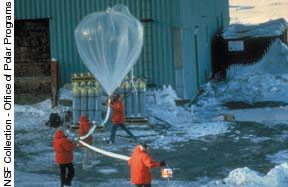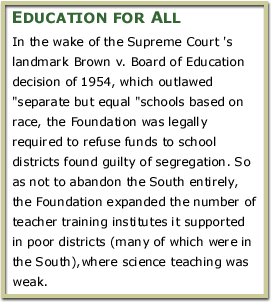
Crisis and Opportunity
 On October 4, 1957, news stunned the world that the Soviet Union (USSR) had launched the first
artificial earth-orbiting satellite, Sputnik I. Politicians, journalists, and citizens wanted to know how
the USSR could have beaten the United States to this crucial goal (it would not be until January 31, 1958,
that the United States would manage to orbit its first satellite, Explorer I).
On October 4, 1957, news stunned the world that the Soviet Union (USSR) had launched the first
artificial earth-orbiting satellite, Sputnik I. Politicians, journalists, and citizens wanted to know how
the USSR could have beaten the United States to this crucial goal (it would not be until January 31, 1958,
that the United States would manage to orbit its first satellite, Explorer I).
Two weeks after Sputnik's launch, members of the National Science Board met in a somber five-hour, closed-door session. The minutes of that October 17, 1957, meeting reveal some of the anguish in their deliberations. The Foundation, after all, had been formed in the earlier emergency of 1949-1950 to help the United States wage the Cold War against the Soviet Union. The Foundation was also supposed to produce an adequate supply of scientists and engineers. Yet now the tabloids were screaming about Soviet superiority in science and technology.
Julius Stratton, president of MIT, said simply, "The Board could not abdicate its responsibility." In response to the crisis, the Board proposed to the President a six-point program, including "more adequate funds . for fundamental research, and an effort . to distinguish in the public mind between basic and applied or developmental research.." Adequate numbers of teachers at all levels were also needed.
For his part, Waterman gave many speeches and testified to Congress about the Nation's need for more research and better science education. Soon, Congress gave the Foundation three supplemental budgets in FY1958. For FY1959, the BOB encouraged NSF to seek $140 million-a whopping $100 million more than NSF's FY1958 appropriation.
 Rockets, balloons, and satellites allowed entirely new ways to study Earth's atmosphere. In response,
NSF sponsored research using these new technologies and was given the job of supervising government weather
modification programs. Other large-scale projects of the era included graduate biological laboratories,
facilities to study marine biology and oceanography, a deep-sea ocean drilling program, and a permanent
program of fieldwork in Antarctica.
Rockets, balloons, and satellites allowed entirely new ways to study Earth's atmosphere. In response,
NSF sponsored research using these new technologies and was given the job of supervising government weather
modification programs. Other large-scale projects of the era included graduate biological laboratories,
facilities to study marine biology and oceanography, a deep-sea ocean drilling program, and a permanent
program of fieldwork in Antarctica.
Congress also became more generous toward NSF's education account. In 1953, Congress funded the first two federally supported summer institutes for college teachers. Thanks largely to congressional appropriations, by 1957 the program had expanded, especially the institutes for high school teachers, to forty-one summer and academic year institutes. Still, some Board members regarded the institutes as diffuse in their mission and their benefits hard to measure.
Sputnik made clear the need to producing more scientists and engineers than were the Americans. NSF accelerated its funding of projects to upgrade high school and undergraduate course materials. Arguably, the new curriculum materials and teacher-training institutes can be regarded as high points in NSF's fifty-year effort to improve education.
